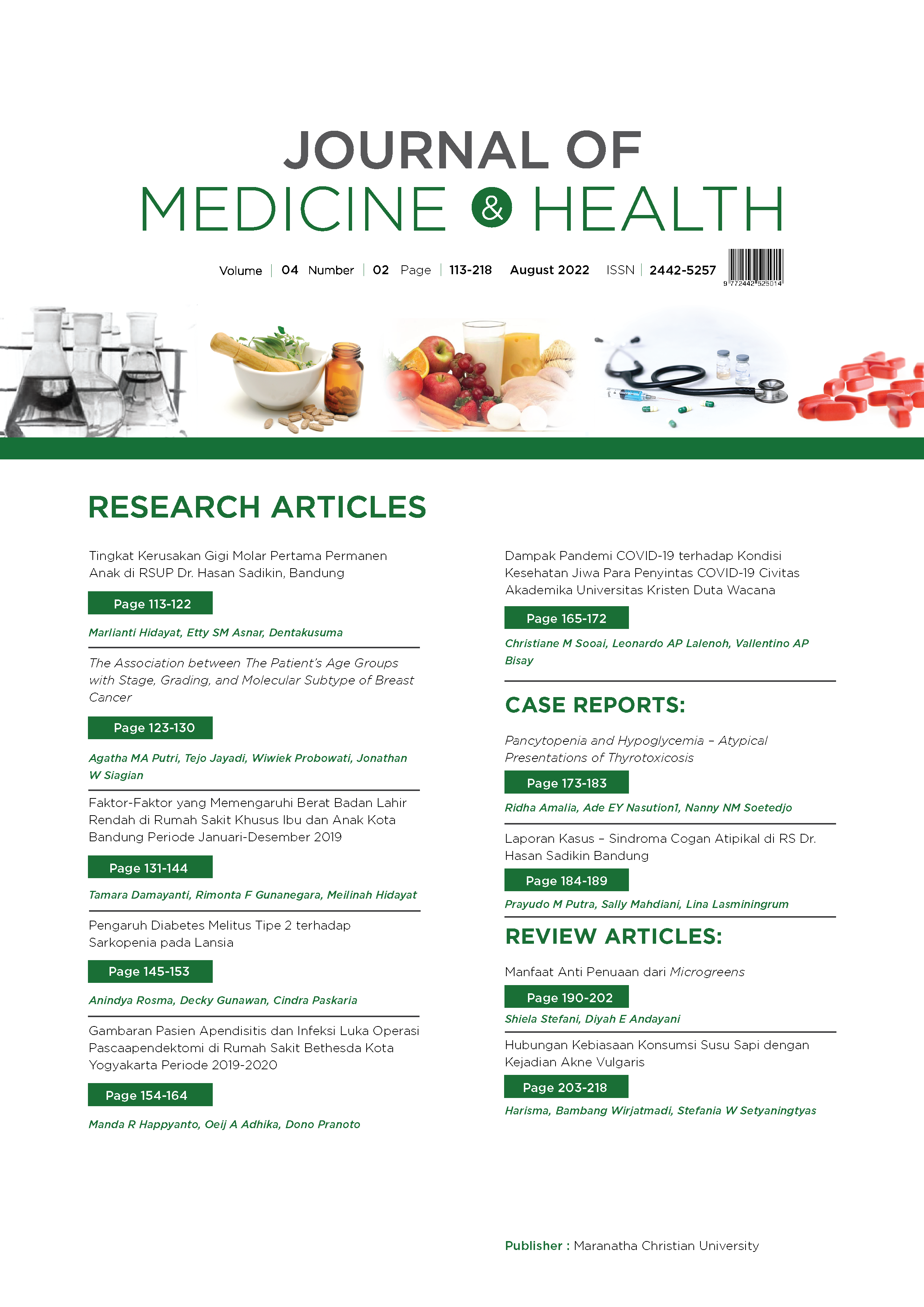Determinant Factors Associated with Low Birth Weight Babies at Sakit Khusus Ibu dan Anak Kota Bandung From January-December 2019
DOI:
https://doi.org/10.28932/jmh.v4i2.3734Kata Kunci:
risk factors, birth weight, low-birth-weight-infantsAbstrak
Low-birth-weight infants refers to the infants born less than 2500 grams. Bandung, has higher rate of low-birth-weight infants (18.58%) compare to the other areas in Indonesia. The purpose of this study is to find the factors which caused the low-birth-weight in the maternity hospitals in Bandung in January to December 2019 with analytical method using case control design. The main sample of this study based on primary data from medical record by whole sampling method, while secondary data was used for sample control by using table of study population. The samples of this study are the mothers who gave birth normally to low-birth-weight infants and the mothers who gave birth to normal infant as the control (1:1). 412 mothers in maternity hospitals in Bandung gave birth to low-birth-weight infants. The result of statistical analysis showed that the mothers’ educational background, gestational age at delivery, body mass index (BMI), smoking habit, number of visit to the antenatal care (ANC), preeclampsia, and infection during pregnancy (p<0.05) affects the low-birth-weight of infants. On the other hand, no relationship was found between low-birth-weight in infants and their mothers’ age, occupation, the parity, the time between pregnancies, and anemia during pregnancy. As conclusion, this study proved that the mothers’ educational background, gestational age at delivery, BMI, smoking habit, number of visit to ANC, preeclampsia, and infection during pregnancy affect the low-birth-weight in infants.Unduhan
Referensi
United Nations Children’s Fund (UNICEF), World Health Organization. UNICEF-WHO Low birthweight estimates: Levels and trends 2000–2015. Geneva: World Health Organization; 2019. [Diunduh pada: 10 Desember 2019], Tersedia dari: https://www.unicef.org/reports/UNICEF-WHO-low-birthweight-estimates-2019
United Nations The Sustainable Development Goals Report. 2019. [Diunduh pada: 10 Desember 2019],
Tersedia dari: https://unstats.un.org/sdgs/report/2019/The-Sustainable-Development-Goals-Report-2019.pdf
World Health Organization (WHO). WHO Global Nutrition Targets 2025: Low Birth Weight Policy. 2019.
Kementrian Kesehatan RI. Hasil Utama Rikesdas 2018. 2018. [Diunduh pada: 10 Desember 2019], Tersedia dari : https://kesmas.kemkes.go.id/assets/upload/dir_519d41d8cd98f00/files/Hasil-riskesdas-2018_1274.pdf
Badan Pusat Statistik. Profil Anak Indonesia 2018. Jakarta: 2018. p.82-3
Kementrian Kesehatan RI. INFO DATIN Pusat Data Dan Informasi Kementrian Kesehatan RI Kondisi Pencapaian Program Kesehatan Anak Indonesia. 2014. p.5
RENSTRA RSUD Kota Bandung Tahun 2013-2018. 2018; [Diunduh pada: 10 Desember 2019], Tersedia dari: https://rsudkotabandung.web.id/?page_id=927
Laami-Kneefe CJ, Couch SC, Philipson EH. Handbook of Nutrition and Pregnancy. Cleveland : 2018.p:40-5
Rini S, Trisna I. Faktor – Faktor Risiko Kejadian Berat Bayi Lahir Rendah Di Wilayah Kerja Unit Pelayanan Terpadu KESMAS Gianyar II. 2015; [Diunduh pada: 10 Desember 2019], Tersedia dari: https://ojs.unud.ac.id/index.php/eum/article/view/13057.
Mahayana S, Chundrayetti E, Yulistini. Faktor Risiko Yang Berpengaruh Terhadap Kejadian Badan Lahir Rendah di RSUP Dr. M. Djamil Padang. J Kesehatan Andalas. 2015;4(3):664–73.
Sujadi A, Gunanegara R, Suwindere W. Hubungan Faktor Risiko Ibu dengan Kejadian Bayi Berat Lahir Rendah Di Rumah Sakit Immanuel Tahun 2011. 2012. [Diunduh pada: 10 Desember 2019], Tersedia dari: https://repository.maranatha.edu/3414/
Andiani C, Paskaria C, Lana B. Faktor – Faktor Yang Memengaruhi Kejadian Bayi Berat Badan Lahir Rendah di Rumah Sakit Immanuel Bandung Tahun 2016. 2016. [Diunduh pada: 10 Desember 2019], Tersedia dari https://repository.maranatha.edu/21838/
Marlenywati, Hariyadi D, Ichtiyati F. Faktor-faktor yang mempengaruhi kejadian BBLR di RSUD dr. Soedarso Pontianak. Vokasi Kesehatan. 2015;1(5):154–60.
Purwanto AD, Wahyuni CU. Hubungan antara umur kehamilan, kehamilan ganda, hipertensi dan anemia dengan kejadian bayi berat lahir rendah (BBLR). Jurnal Berkala Epidemiologi, 2016;4(3): 349–59.
Guyton AC, Hall JE. Guyton and Hall Textbook of Medical Physiology (12th Edition ed.). 2010. p 999-1003
Cohen WR. Does maternal age affect pregnancy outcome? BJOG An Int J Obstet Gynaecol. 2014;121(3):252–4.
Nurahmawati D, Salimo H, Dewi YLR. Effects of Maternal Education, Psychosocial Stress, Nutritional Status at Pregnancy, and Family Income, on Birthweight in Nganjuk, East Java. J Matern Child Heal. 2017;02(04):324–34.
Oyekale AS, Maselwa TC. Maternal education, fertility, and child survival in comoros. Int J Environ Res Public Health. 2018;15(12): 339-45
Wahyu E. Hubungan Faktor Ibu dan Paritas dengan Kejadian Bayi Berat Lahir Rendah di RSU PKU Muhammadiyah. 2017. [Diunduh pada: 25 Agustus 2020], Tersedia dari: http://digilib.unisayogya.ac.id/2575/1/NASKAH%20PUBLIKASI%20%20WAHYU%20ERNAWATI%201610104247.pdf
Fajriana A, Buanasita A. Faktor Risiko Yang Berhubungan Dengan Kejadian Bayi Berat Lahir Rendah Di Kecamatan Semampir Surabaya. Media Gizi Indones. 2018;13(1):71-5
Paramitasari N, Salimo H, Murti B. The Effect of Biological, Social, Economic, and Nutritional Factors on Low Birth Weight: A New Path Analysis Evidence from Madiun Hospital, East Java, Indonesia. J Matern Child Health. 2018;03(03):166–75.
American College of Nurse-Midwives and the National Association of Nurse Practitioners in Women’s Health; American College of Obstetricians and Gynecologists and the Society for Maternal–Fetal Medicine, Louis JM, Bryant A, Ramos D, Stuebe A, Blackwell SC. Interpregnancy Care. Am J Obstet Gynecol. 2019 Jan;220(1):B2-B18. doi: 10.1016/j.ajog.2018.11.1098. Epub 2018 Dec 20. PMID: 30579872.
Trisnowati H, Wahyuningsih CS. Paparan Asap Rokok dalam Rumah dan Berat Bayi Lahir Rendah (Studi pada Rumah Sakit di Wonosaro, Yogyakarta). 3rd Indones Conf Tob or Heal Novemb 25-27, 2016. 2017:1–7.
Cunningham F, Leveno K, Bloom S, Spong C, Dashe J, Hoffman B , et al. Williams Obstetrics (24th Edition ed.). New York: The McGraw-Hill Companies. 2014 p:891-913
Chelchowska M, Ambroszkiewicz J, Jablonka-Salach K, Gajewska J, Maciejewski TM, Bulska E, et al. Tobacco smoke exposure during pregnancy increases maternal blood lead levels affecting neonate birth weight. Biol Trace Elem Res. 2013;155(2):169–75.
Bejar II. Nutritional Intervention: A Secondary Analysis of Its Effect on Malnourished Colombian Pre-Schoolers. Eval Health Prof. 2016;4(2):145–72.
Poon LC, Shennan A, Hyett JA, Kapur A, Hadar E, Divakar H, et al. The International Federation of Gynecology and Obstetrics (FIGO) initiative on pre-eclampsia: A pragmatic guide for first-trimester screening and prevention. Int J Gynecol Obstet. 2019;145(S1):1–33.
Susilowati E, Wilar R, Salendu P. Faktor risiko yang berhubungan dengan kejadian berat badan lahir rendah pada neonatus yang dirawat di RSUP Prof. Dr. R. D. Kandou periode Januari 2015-Juli 2016. e-CliniC. 2016;4(2):1-7.
Sharma M. Maternal risk factors and consequences of low birth weight in Infants. IOSR J Humanit Soc Sci. 2013;13(4):39–45.
Adams Waldorf KM, McAdams RM. Influence of infection during pregnancy on fetal development. Reproduction. 2013;146(5):151-62
Safithri SF, Kania N, Diana A. Correlation between Maternal Hemoglobin Level and Birth Weight. Althea Med J. 2019;6(2):91–4.
##submission.downloads##
Diterbitkan
Cara Mengutip
Terbitan
Bagian
Lisensi
Hak Cipta (c) 2022 Tamara Damayanti, Rimonta F Gunanegara, Meilinah Hidayat

Artikel ini berlisensi Creative Commons Attribution-NonCommercial 4.0 International License.
Authors who publish with this journal agree to the following terms:
- Authors retain the copyright and grant the journal right of first publication with the work
simultaneously licensed under a Creative Commons Attribution-NonCommercial 4.0 International License that allows others to share the work with an acknowledgement of the work's authorship and initial publication in this journal. - Authors are able to enter into separate, additional contractual arrangements for the nonexclusive distribution of the journal's published version of the work (e.g., post it to an institutional repository or publish it in a book), with an acknowledgement of its initial publication in this journal.
 This work is licensed under a Creative Commons Attribution-NonCommercial 4.0 International License.
This work is licensed under a Creative Commons Attribution-NonCommercial 4.0 International License.















